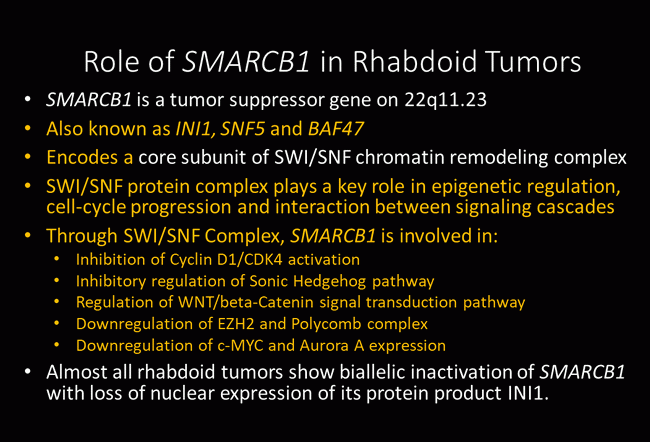Role of SMARCB1/INI1 in Malignant Rhabdoid Tumors


Comments:
SMARCB1 as a key component of SWI/SNF protein complex is involved in the following pathways. Regulation of cyclin D1/CDK4 Activation: SMARCB1 represses Cyclin D1 transcription and inhibits the action of cyclin-dependent kinase (CDK4) during G1 phase of cell cycle and blocks progression to S phase. The cells accumulate in G0/G1 phase. In this function, SMARCB1 signals via the p16-INK4a-Rb-E2F pathway to stabilize the cell cycle. Sonic Hedgehog (SHh) Pathway: SHh pathway is an important regulator of cell proliferation, cellular differentiation, and tissue polarity during embryogenesis. SMARCB1 is a key inhibitory regulator of this pathway. It directly prevents transcription of several downstream SHh pathway target genes such as glioma-associated oncogene homolog (GLI) family of zinc transcription factors (GLI1, GLI2, GLI3) and protein patched homolog 1 (PTCH1). WNT/B Catenin Signal Transduction Pathways: WNT signaling pathways consist of two main groups: 1) Canonical WNT (beta-catenin dependent) - which play a role in regulating cell fate, proliferation and survival. It is aberrantly activated in several cancers; and 2) Noncanonical WNT (beta-catenin independent) pathway - which is regulates cell differentiation, cell polarity and migration. SMARCB1 deficiency leads to aberrant activation of canonical WNT pathway with WNT/beta-catenin overexpression. SMARCB1 interaction with Polycomb Complex: Polycomb proteins, when activated, cause epigenetic silencing of genes during proliferation and development. They are also believed to play an important role in oncogenic transformation. Polycomb proteins form two distinct multiprotein complexes PRC1 and PRC2. EZH2 is an important enzymatic subunit of PRC2 catalyzes its gene silencing function. It is overexpressed in many cancers and has been linked to tumor progression and poor prognosis. SMARCB1 downregulates transcription of EZH2. SMARCB1-deficient tumors show overexpression of EZH2 with resultant repression of Polycomb-regulated genes due to epigenetic silencing. Other targets of SMARCB1/INI1: SMARCB1 plays a role in the expression of c-MYC and Aurora A. c-MYC is a regulatory gene that codes for a transcription factor involved in cell cycle progression, apoptosis, and cell transformation. SMARCB1-deficiency causes significant upregulation of c-MYC. Aurora A is a member of serine/threonine kinase family which play important roles during mitosis and meiosis. Like c-MYC, there is upregulation of Aurora A in SMARCB1-deficient malignant rhabdoid tumors. References:1. Kohashi K and Oda Y. Oncogenic roles of SMARCB1/INI1 and its deficient tumors. Cancer Science, April 2017; vol. 108, no. 4, 547-552. 2) Kalimuthu S and Chetty R. Gene of the month: SMARCB1. J Clin Pathol 2016;69:484-489.



